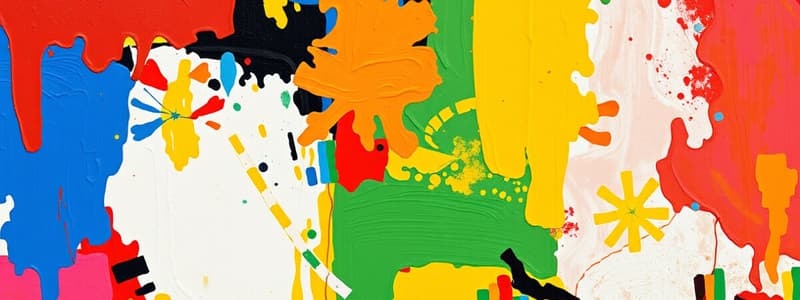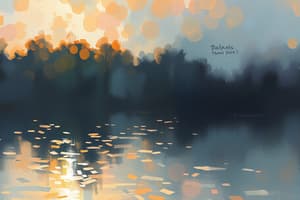Podcast
Questions and Answers
What are the three properties of color?
What are the three properties of color?
- Hue, Value, Intensity (correct)
- Saturation, Tone, Temperature
- Brightness, Clarity, Contrast
- Light, Shape, Texture
What distinguishes one gradation of color from another?
What distinguishes one gradation of color from another?
Hue
What is the term for the degrees of lightness and darkness in a color?
What is the term for the degrees of lightness and darkness in a color?
Value
What does intensity describe in relation to color?
What does intensity describe in relation to color?
What is produced when a beam of light passes through a prism?
What is produced when a beam of light passes through a prism?
What are the three primary colors?
What are the three primary colors?
What colors result from mixing two primary colors?
What colors result from mixing two primary colors?
What are colors produced by mixing a primary color with a secondary color called?
What are colors produced by mixing a primary color with a secondary color called?
What are two colors that are directly opposite each other on the color wheel called?
What are two colors that are directly opposite each other on the color wheel called?
What colors are known as neutral colors?
What colors are known as neutral colors?
What is the result when all primary colors are combined as light?
What is the result when all primary colors are combined as light?
What is subtractive color mixing?
What is subtractive color mixing?
What term describes how colors are perceived based on their proximity to other colors?
What term describes how colors are perceived based on their proximity to other colors?
What are color harmonies or color schemes?
What are color harmonies or color schemes?
What is a triad color harmony?
What is a triad color harmony?
What is a split complementary color scheme?
What is a split complementary color scheme?
What colors are related in an analogous colors scheme?
What colors are related in an analogous colors scheme?
What is meant by monochromatic colors?
What is meant by monochromatic colors?
What is a tint in relation to color?
What is a tint in relation to color?
What is a shade in terms of color?
What is a shade in terms of color?
What does tone refer to regarding colors?
What does tone refer to regarding colors?
What are warm colors characterized by?
What are warm colors characterized by?
What defines cool colors?
What defines cool colors?
Flashcards are hidden until you start studying
Study Notes
Color Fundamentals
- Color is an element of art characterized by hue, value, and intensity, representing surfaces' visual responses to light wavelengths.
Definitions of Color Properties
- Hue: A distinguishing property of color that gives it a name and identifies its gradation.
- Value: Refers to the lightness or darkness of a color, fundamental in art for creating contrast.
- Intensity: Indicates the saturation or purity of a color, with high intensity being bright and vivid, while low intensity appears dull.
Color Theory
- Spectrum: A visible band of colors produced when light passes through a prism, encompassing the full range of colors.
- Primary Colors: Red, yellow, and blue are the foundational colors that cannot be created by mixing other pigments. They serve as the base for mixing all other colors.
- Secondary Colors: Result from mixing two primary colors; include green, orange, and violet.
Advanced Color Mixing
- Intermediate (Tertiary) Colors: Formed by mixing a primary color with a secondary color, such as red and violet creating red-violet.
- Complementary Colors: Colors opposite each other on the color wheel, like red and green, providing strong contrast.
- Neutral Colors: Include black, white, and gray; not associated with any hue, can be created through mixing colors with neutrals or compliments.
Mixing Techniques
- Additive Color Mixing: Involves the mixing of colored light, with all primary colors together yielding white light.
- Subtractive Color Mixing: Concerned with pigments; combining primary colors results in black.
Perception of Color
- Color Interactions: Describes how colors affect each other's perception based on proximity.
- Color Harmonies/Schemes: Various combinations of colors that create pleasing effects or patterns.
Types of Color Schemes
- Triadic Colors: Three colors equally spaced on the color wheel, e.g., red, blue, and yellow.
- Split Complementary Colors: A main color paired with the two adjacent colors of its complementary color, such as red with blue-green and yellow-green.
- Analogous Colors: Colors that are next to each other on the color wheel, creating harmony, for instance, green, yellow-green, and yellow.
- Monochromatic Colors: Variants of a single hue modified by adjusting its value and saturation with black and white.
Modifying Color Values
- Tint: A lighter version of a hue achieved by adding white.
- Shade: A darker version of a hue obtained by adding black.
- Tone: A medium value of a hue created by adding gray.
Warm and Cool Colors
- Warm Colors: Hues dominated by red and yellow, often evoking warmth and energy.
- Cool Colors: Hues where blue is dominant, generally associated with calmness and tranquility.
Studying That Suits You
Use AI to generate personalized quizzes and flashcards to suit your learning preferences.



